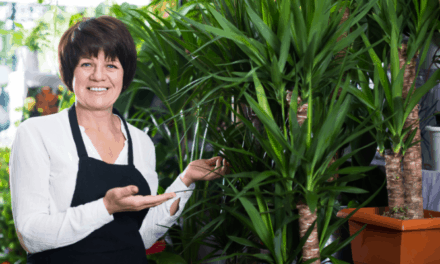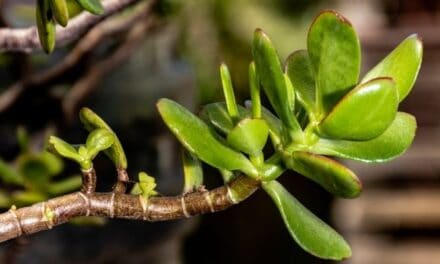The sensitive plant (Mimosa pudica) is a wonderful plant to get children interested in plant care.
It reacts to a physical touch by folding in its leaves and making its branches droop.
It’s really quite amazing to see a plant react like an animal but the sensitive plant is sensitive in more ways than one and one of the first signs of stress that this plant will show is the yellowing of its leaves.
Table of Contents
Why Is My Sensitive Plant Turning Yellow?

Your sensitive plant is turning yellow because it has either been watered too much or it is not receiving enough sunlight.
Those are the two most common reasons why a sensitive plant will start turning yellow but there are other factors that can also influence this.
As a potted houseplant, your sensitive plant is very sensitive to its environment and not just being touched.
Unless the plant’s needs for water and light are being met precisely, its leaves may yellow and begin to drop off.
Even when sensitive plants are thriving, they often drop older lower leaves as they grow new upper leaves.
These plants rarely do as well when kept indoors as they do in the wild and when you don’t perfectly meet the needs for their care, their health can go downhill pretty fast.
Try Not To Touch Your Sensitive Plant Too Much
When you touch these plants they quickly fold their leaves and sometimes droop, too.
It can be lots of fun to do and see, especially for kids – but you have to remember that the plant is reacting this way because it is feeling stressed out from being touched.
By whichever means, continuous stress is not good for your plant and may eventually impact its health.
Touching its leaves to get a reaction once in a while won’t do it any harm but I wouldn’t go touching it every time you walk past.
Also, as sensitive plants get older they react less to touch.
You Might Also Like To Read: Does Touching Succulents Hurt Them? (Not Always)
Understanding Your Sensitive Plant
This plant is used to an abundance of light and humidity since its native home is in subtropical North America.
In fact, it prefers a bright, humid environment.
Just don’t give it too much intense sunlight in the middle of the day.
It is a bit sensitive to heat, however.
An indoor temperature on the cool side (say, between 68 and 70 degrees Fahrenheit) should be fine.
To prevent or reverse the yellowing of your sensitive plant, it’s important to understand how it likes to be cared for.
Mimosa pudica commonly referred to as “Sensitive Plant,” is quite interesting as a houseplant.
It can even be grown from seed.
Children will find its touch-me-not behavior fascinating.
When you touch the plant or expose it to heat, it reacts by quickly folding in its leaves and bowing down.
It is really interesting to see.
Unfortunately, this plant’s lifespan is limited because it is an annual plant, typically thriving for only one growing season.
During its short but interesting life, it is sensitive to a variety of factors in its environment.
Sunlight
Sensitive plants require lots of bright indirect light in order to thrive.
If they don’t receive enough light, they may close up their leaves, reduce photosynthesis, and stop them from producing their pink fluffy flowers.
Just be sure not to leave this plant in the direct afternoon sunlight as it can quickly get sunburned.
A little bit of weaker morning sunlight is okay but as the midday sun gets stronger, ensure it’s just getting lots of bright indirect sunlight.
An east-facing window is usually good or a sheer curtain to filter out the full sun.
Soil
Sensitive plants are not overly picky when it comes to soil.
Use a loose, well-drained, high-quality potting mix and they should do fine.
Ensure the soil is loose and loamy because the tiny roots of your sensitive plant will really struggle in compacted soil.
Another factor and one that can cause it most harm is also something it requires to survive: water.
Humidity
Sensitive plants like high humidity so it may be worth investing in a humidifier.
You can also raise humidity for the plant by keeping it in a bathroom, keeping it close to other plants that perspire a lot, or keeping it on a wet pebble tray.
Just ensure that the plant is never sitting in water.
Sensitive Plants Are Quite Sensitive To Water
Not everyone realizes that Mimosa pudica is so sensitive to the amount of water it is given and an excess of water can very quickly lead to rot and yellowing of its leaves.
You must find just the right balance between dryness and moisture for your sensitive plant to thrive.
Keep the soil moist, but let the top half-inch of surface soil get almost dry to the touch before re-watering.
Do not allow the soil to get soggy.
If watering from below, empty any excess water from the drainage dish and always check that the plant’s roots are not sitting in water.
Why Does Too Much Water Harm Your Sensitive Plant?
An excess of water around roots can drown plants.
Like us, they need air to survive.
Surrounding tiny roots with water prevents them from getting the oxygen they require from the soil, and the plant will eventually show telltale signs of overwatering.
These signs include when the tips of leaves turn yellow, gradually spreading to the rest of the plant.
Alternatively, your overwatered sensitive plant may develop yellow spots on its green leaves.
The plant may appear to have an insect infestation or disease, although it’s probably just waterlogged.
Can Underwatering Also Cause Yellow Leaves?
Underwatering can also harm your sensitive plant.
If your plant gets thirsty, you’ll be able to tell by feeling the soil.
If it is completely dry, water your plant right away.
Lack of water can cause yellowing and browning of leaves, but they will look dry and brittle rather than diseased.
Pests And Diseases
Sensitive plants, when kept as houseplants, are usually not bothered by any insects, other than spider mites.
You’ll identify these pests as little red dots or a rough and gritty texture on your sensitive plant.
Rub affected areas with a diluted alcohol mixture of about 3 parts water to one part alcohol.
The high humidity that this plant likes is also the environment many fungal diseases enjoy.
To reduce the risk of a fungal infection, ensure there is good air circulation around your sensitive plant.
A nearby fan will help.
Just don’t aim directly at your plants, aim the fan so the air is indirectly bouncing around the room.
Can Anything Else Affect The Health Of My Sensitive Plant?
Yes. Poor drainage, root crowding, a lack of proper soil nutrients, and the wrong pH balance can also impact the health of your sensitive plant.
Always use a pot with good drainage so the plant’s roots are never left in waterlogged soil.
Crowded (compacted) roots can also be a source of yellow leaves because the plant’s little root system is struggling to breathe.
Plants need sufficient nutrients to make chlorophyll (food for the plant, and the pigment that gives it its green coloration).
Without chlorophyll, the plant develops “chlorosis,” the scientific name for yellow leaves.
Some of the nutrients plants require include nitrogen, potassium, magnesium, iron, and sulfur.
These naturally occur in soil, are plentiful in potting soil, and can be supplemented via commercial plant fertilizers.
But although there are many possible causes for yellow leaves, for sensitive plants, it is almost always because of overwatering.
The symptom of yellow leaves on your sensitive plant could be a sign of a previous overwatering condition, one it experienced in the plant nursery before you adopted it.
And yellow leaves due to overwatering can appear very fast, especially in quickly-growing plants like Mimosa pudica.
What To Do If Your Sensitive Plant Is Turning Yellow
If you notice that your sensitive plant is turning yellow, then some part of its care is not as it should be.
- Check pot drainage and check the soil to see if it’s too dry or wet and water the plant or let it dry out according.
- Check to see if it’s in a spot where it’s getting the amount of light it likes.
- Check your plant for pests and treat it if you find any.
Final Thoughts
The sensitive plant is actually quite tolerant as a houseplant, as long as you make an effort to provide the environmental conditions it likes.
And you should be able to reverse any issues like the yellowing of leaves by examining its conditions, working out what is out of balance, and taking action quickly to remedy the problem.




